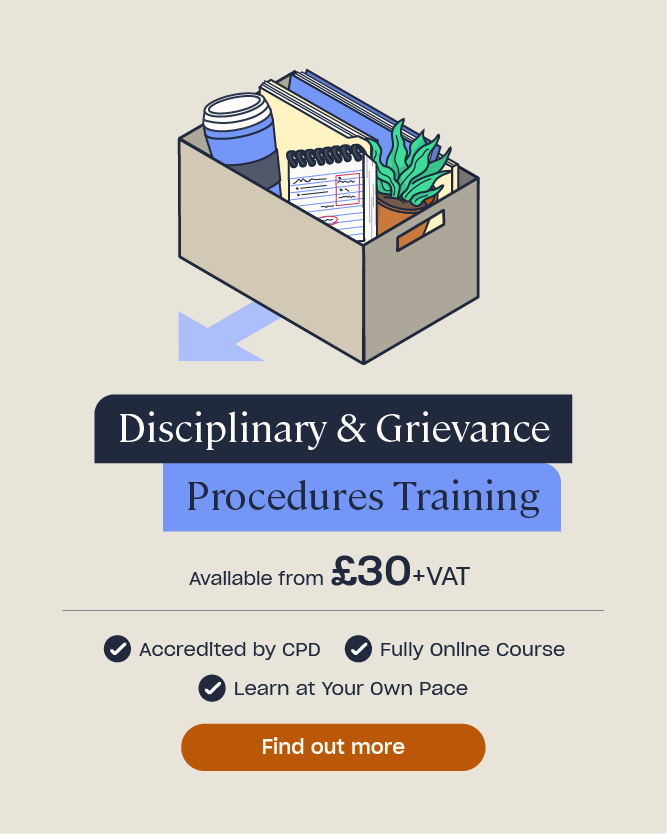Disciplinary Procedures in the Workplace: Guide for Employers
If you’re a manager, supervisor, or someone working in human resources (HR), you’ll need to know the details of a basic disciplinary and grievance procedure.
Any disciplinary process needs to be fair and transparent at all times. Communication is key and at no point should you spring news of dismissal upon an employee – unless, of course, the employee is being dismissed for gross misconduct.
This article will help employers, managers, supervisors, and members of HR understand how to go about conducting a fair and appropriate disciplinary hearing. We will reference employers as the overarching term for those leading the disciplinary process.
Did you know…
The Worker Protection Act 2023 changes came into effect for all businesses in October 2024. The Act places a new legal obligation on employers to take reasonable steps to prevent sexual harassment in the workplace. Our Sexual Harassment Training course helps businesses comply with their new responsibilities.
What is the Purpose of Disciplinary Procedures in the Workplace?
The purpose of a disciplinary procedure in the workplace is to set out how employee misconduct will be dealt with. This procedure is usually outlined within a policy and should be available for all employees to access and detail what behaviours or performance issues could lead to disciplinary action. Having disciplinary procedures in place helps to ensure a consistent, transparent and fair process for all.
However, not all workplace issues require such formal action to be taken. It may be appropriate, in the first instance, to have an informal chat about an issue. The aim of this would be to discuss how the problem can be resolved going forwards and highlight any support the employee may require. Communication skills are a vital element of our working relationships.
This could include further training that’s needed, more effective one-to-ones, or any other support both you and the employee feel may help support a change in their performance or behaviour.
It depends on your workplace’s policies and procedures, but an informal discussion like this wouldn’t always require the employer to put it on record – unless they deemed it necessary. If, or course, the issue continues, it would then be appropriate to consider a more formal disciplinary action.
A standard disciplinary process follows several steps, with different potential outcomes possible at the end.

Disciplinary Procedure Steps
A formal disciplinary procedure should include the following steps:
An investigation – if it is decided that an investigation is required, this should involve the employer gathering as much information as possible regarding the employee’s alleged misconduct.
Any disciplinary action that is taken must be justified; therefore, finding out the facts and establishing evidence to inform any decision that’s to be made is a key part of the procedure. All information regarding the investigation should be accurately recorded.
A hearing – should the investigation find evidence to show an employee’s misconduct, they should then be invited to attend a hearing. This disciplinary meeting involves all the evidence being heard so that a final decision can be made regarding the appropriate course of disciplinary action to take, if any.
An outcome decision – having considered the findings of the investigation and hearing, a fair and justifiable decision should be made on the most appropriate course of action. That possible outcomes in place within your organisation should be outlined within the disciplinary policy.
For a decision to be reached, it may require further discussion between appropriate parties before a decision is reached, such as HR, legal representatives or other senior leaders. This will vary between organisations and the nature of the misconduct.
An opportunity to appeal the decision – the employee should be offered the right to appeal if they disagree with the outcome.
The next section will look in greater detail at what is involved in a disciplinary hearing, how to prepare for one and what to expect during and after the meeting.
Need a Course?
Our Disciplinary & Grievance Procedures Training is designed to help managers and employers ensure that they have a fair and consistent disciplinary procedure in their workplace. This and further useful training resources can be found within our Business Essentials course catalogue.
How to Conduct a Disciplinary Hearing
Remember, a disciplinary hearing is a formal action and one that should be completed in-line with company policies and procedures. It should be carried out fairly, with all steps taken to ensure all parties rights are met and that all proceedings are accurately recorded and documented throughout.
Preparing for a Disciplinary Hearing
As part of the preparation for the hearing, the employer should put certain information in writing to the employee, so they are fully aware of the following:
- Details of their alleged misconduct.
- The evidence that supports the employer’s claim.
- Their right to bring their own supporting evidence.
- The possible outcomes of the hearing.
- Their right to representation.
- When and where the hearing will take place.
It is important to understand the rights of the employee, as failing to comply with these could lead to an unfair process. For example, if the disciplinary procedure is outlined within an employee’s contract and as the employer you have failed to adhere to, you could be held liable for a breach of contract and unfair dismissal.
It is also good practice to deal with all stages of a disciplinary process in good time and without any unnecessary delays.

What Happens at a Disciplinary Meeting?
During the meeting, both the employer and the employee will have the opportunity to speak and share evidence. In disciplinary cases, emotions and tensions may be running high, so it is important to have a clearly set out structure to the meeting and to allow everyone their turn to speak, uninterrupted.
Being skilled in conflict resolution can be hugely beneficial when it comes to bringing constructive outcomes from difficult situations.
The employer will begin by explaining the alleged misconduct, talking through and showing any supporting evidence they may have, including witnesses. All of this should have been provided to the employee in advance of the hearing, so they understand what to expect and also have the time to prepare their own case.
For the hearing to be fair, it is important that the employee gets to explain their case, respond to the allegations and provide their own evidence, including witnesses. They should also be given the chance to ask any questions they may have.
Notes should be taken throughout the disciplinary hearing and every effort should be made to ensure the employee attends the meeting. An employee may request to bring someone with them and they have the right to bring, a colleague, a union representative, or an official employed by a trade union.
If the employee requests to bring anyone else, this would be at the employer’s discretion and they do not have to accommodate the request.

What Happens After a Disciplinary Hearing?
Once the meeting is drawing to a close, it is important to clarify the next steps so that the employee knows when to expect a decision and what steps they can take if they disagree with the outcome. The type of disciplinary action taken will depend on the severity of the misconduct.
The potential disciplinary actions that may be taken are:
No action – it may be found that a misconduct has not taken place, in which case it should be made clear to the employee that the case has been dropped and they should be supported to positively continue their employment.
Verbal warning – also known as an informal warning. As mentioned previously, this is where an issue was found to be small and one that can be resolved with an informal discussion and perhaps additional support to rectify the problem. Having gone through the disciplinary procedures, the employer may choose to make a note of this warning for future reference, despite it being ‘informal’.
First written warning – this is a formal warning and is one that is usually the first action taken if it is shown misconduct has taken place. At this stage, the employer may give the employee a timescale, to either show improvement (in the case of poor performance), or within which they must not repeat the misconduct.

Final written warning – this can take place if the employee did not meet the requirements set out within the first written warning, or the misconduct were more severe in nature and met the companies requirements to skip the first written warning and action the final warning instead.
Dismissal – if, following a final written warning, the employee either does not improve or repeats unwanted behaviour, then the employer may have no choice but to move to a dismissal. If an employee acts in a way that falls under ‘gross misconduct’, the employer may move to dismissal without any verbal or written warning being required.
Regardless of the outcome decided, it is important that the employee understands their right to appeal. It must be clearly explained how to do so, and any information they need to be able to make their appeal should be provided.
They should set out in writing what grounds they have for making the appeal – with the employer responding with when and where the appeal hearing will take place.
Disciplinary Meeting Tips for Employers
The most effective way of approaching disciplinary processes and meetings is to ensure they are fair, reasonable and respectful. It can be a highly emotive time for all involved and it is important that a calm, professional manner is adopted at all times.
Always act in-line with your company’s policies and procedures, making sure the process is one that aims to support positive change to staff’s behaviour and performance where appropriate.
There will be times when staff do not attend meetings. This may be because they fail to turn up or are absent due to sick leave. As an employer you should make every effort to ensure staff have the information and support they require to attend.

Rescheduled appointments should be made for those that fail to attend.
If a failure to attend scheduled meetings continues to occur, there are several options that could be taken. It may be beneficial to involve occupational health or HR, as they may be best placed to decide if any reasonable adjustments could be made to help the employee attend, or they may determine that they are too unwell and attendance at that time is not appropriate.
After further investigation, the decision could be taken to postpone the meeting until their return from sick leave, that submitting their case in writing would be the best course of action, or that they should engage a representative instead.
It could also be determined that the employee is failing to attend on purpose, in such a case it may be necessary to decide the outcome of disciplinary action in their absence.
Always communicate how and why a particular decision was reached clearly and in writing.
Further Resources:
- Disciplinary & Grievance Procedures Training
- How to Conduct a Grievance Hearing: Tips for Employers
- Understanding the Different Types of Group Conflict: A Guide for Managers
- How to Use Key Phrases in Performance Reviews & Appraisals
- Signs of Conflict in the Workplace
- Managing Conflict in the Workplace: A Guide for Line Managers
- Importance of Respect in the Workplace











